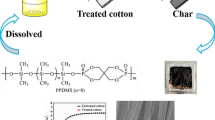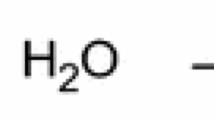Abstract
Sodium lignin sulfonate (SLS) has been explored as a fire retardant finishing agent on cotton fabric. 30% [w/v] SLS treated cotton fabric has registered LOI value of 28.5 with minimum char length of 4 cm (self-extinguishment) whereas control cotton fabric was found to burn out with flame and afterglow within 1 min. Thermo-gravimetry of the treated cotton fabric showed 35% mass retention at 500 °C while only 8% char mass was left for the control cotton fabric at the said temperature. Volatile species liberated during burning were analyzed by GC–MS technique which demonstrated the restriction of flammable gas formation from the SLS treated fabric. Char mass left after burning also has been characterized in terms of its morphology, elemental analysis, etc. Moreover, it has also been proven that SLS treatment imparts a natural attractive yellow color, UV protective property to the treated fabric without altering physical strength of the fabric which can be considered as an added advantage over flame retardant effect.
Graphic abstract











Similar content being viewed by others

References
Alongi J, Carletto RA, Blasio AD, Cuttica F, Carosio F, Bosco F, Malucelli G (2013a) Intrinsic intumescent-like flame retardant properties of DNA-treated cotton fabrics. Carbohydr Polym 96:296–304
Alongi J, Carletto RA, Blasio AD, Carosio F, Bosco F, Malucelli G (2013b) DNA: a novel green natural flame retardant and suppressant for cotton. J Mater Chem A 1:4779–4785
Alongi J, Carletto RA, Bosco F, Carosio F, Blasio AD, Cuttica F, Antonucci V, Giordano M, Malucelli G (2013c) Caseins and hydrophobins as novel green flame retardant for cotton fabrics. Polym Degrad Stabil 99:111–117
Alongi J, Carletto RA, Bosco F, Carosio F, Blasio AD, Cuttica F, Antonucci V, Giordano M, Malucelli G (2014a) Caseins and hydrophobins as novel green flame retardants for cotton fabrics. Polym Degrad Stab 99:111–117
Alongi J, Cuttica F, Blasio AD, Carosio F, Malucelli G (2014b) Intumescent features of nucleic acids and proteins. Thermochim Acta 591:31–39
Alongi J, Blasio AD, Milnes J, Malucelli G (2015) Thermal degradation of DNA, an all in one natural intumescent flame retardant. Polym Degrad Stabil 113:110–118
Alongi J, Cuttica F, Carosio F (2016) DNA coatings from byproducts: a panacea for the flame retardancy of EVA, PP, ABS, PET and PA6. ACS Sustain Chem Eng 4(6):3544–3551
Angelini S, Barrio A, Cerruti P, Scarinze G, Jacca JG, Savy D, Piccolo A, Malinconico M (2019) Lignosulfonates as fire retardants in wood flour based particle boards. Int J Polym Sci. https://doi.org/10.1155/2019/6178163
Azis MM, Rachmadi H, Wintoko J, Yulian AT, Hasokowatki W, Purwono S, Rochamandi W (2016) On the use of sodium lignosulfonate for enhanced oil recovery. IOP Conf Ser Earth Environ Sci 65:1–7
Basak S, Ali SW (2016) Sustainable fire retardancy of textiles using bio-macromolecules. Polym Degrad Stab 133:47–64
Basak S, Ali SW (2017) Leveraging flame retardant efficacy of pomegranate rind extract, a novel biomolecule, on ligno-cellulosic materials. Polym Degrad Stab 144:83–92
Basak S, Ali SW (2018) Fire resistant behaviour of cellulosic textile functionalised with wastage plant bio-molecules: a comparative scientific report. Int J Biol Macromol 114:169–180
Basak S, Ali SW (2019) Wastage pomegranate rind extracts (PRE): a one step green solution for bioactive and naturally dyed cotton substrate with special emphasis on its fire protection efficacy. Cellulose 26:3601–3623
Basak S, Samanta KK, Chattopadhyay SK, Narkar R (2015) Self-extinguishable ligno-cellulosic fabric made by banana pseudostem sap. Curr Sci 108:372–383
Basak S, Patil PG, Shaikh AJ, Samanta KK (2016) Green coconut shell extract and boric acid: new formulation for making thermally stable cellulosic paper. J Chem Technol Biotechnol 91:2871–2881
Basak S, Samanta KK, Chattopadhyay SK, Narkar R, Parmar MS (2017) Wastage spinach leaf: Source for making self-extinguishable cellulosic substrate. Ind J Fibre Text Res 42:215–222
Bosco F, Carletto RA, Alongi J, Marmo L, Blasio AD, Malucelli G (2013) Thermal stability and flame resistance of cotton fabrics treated with whey proteins. Carbohydr Polym 94:372–377
Brebu M, Vasile C (2010) Thermal degradation of lignin: a review. Cell Chem Technol 44:353–363
Cayla A, Rault F, Giraud S, Salaün F, Fierro V, Celzard A (2016) PLA with intumescent system containing lignin and ammonium polyphosphate for flame retardant textile. Polymers 8:331–339
Chirico AD, Armanini M, Chini P, Cioccolo G, Provasoli F, Audisio G (2003) Flame retardants for polypropylene based on lignin. Polym Degrad Stab 79:139–145
Costes L, Laoutid F, Brohez S, Delvosalle C, Dubois P (2017) Phytic acid–lignin combination: a simple and efficient route for enhancing thermal and flame retardant properties of polylactide. Eur. Polym. J. 94:270–285
Costes L, Aguedo M, Brison L, Brohez S, Richel A, Lautid F (2018) Lignin fractionation as an efficient route for enhancing polylactide thermal stability and flame retardancy. Flame Retard Therm Stab Mater 1:14–24
Ferry L, Dorez G, Taguet A, Otazaghine B, Lopez Cuesta JM (2015) Chemical modification of lignin by phosphorous molecules to improve the fire behavior of polybutylene succinate. Polym Degrad Stabil 113:135–143
Horrocks AR (1986) Flame-retardant finishing of textiles. Rev Prog Color Relat Top 16:62–101
Horrocks AR (2011) Flame retardant challenges for textiles and fibres: new chemistry versus innovatory solutions. Polym Degrad Stab 96:377–392
Horrocks AR (2013) Textile flammability research since 1980: personal challenges and partial solutions. Polym Degrad Stab 98:2813–2824
https://www.greenagrochem.com/products/sodium-lignosulfonate/. Retrieved 25 May 2019
Hu J, Shen D, Wu S, Zhang H, Xiao R (2014) Effect of temperature on structure evolution in char from hydrothermal degradation of lignin. J Anal Appl Pyrolysis 106:118–124
Jakab E, Faix O, Till F, Szekely T (1993) The effect of cations on the thermal decomposition of lignins. J Anal Appl Pyrol 25:185–194
Kleen M, Gellerstedt G (1995) Influence of inorganic species on the formation of polysaccharide and lignin degradation products in the analytical pyrolysis of pulps. J Anal Appl Pyrol 35:15–41
Mendis GP, Weiss SG, Korey M, Boardman CR, Bietenberger M, Youngblood GP, Howarter JA (2016) Phosphorylated lignin as a halogen free flame retardant additive for epoxy composites. Green Mater 4(4):150–159
Morgan AB, Bundy M (2007) Cone calorimeter analysis of UL-94 V-rated plastics. Fire Mater 31:257–283
Nazare S, Kandola B, Horrocks R (2002) Use of cone calorimetry to quantify the burning hazard of apparel fabrics. Fire Mater 26:191–199
Northey RA (2002) The use of lignosulfonate as water reducing agent in the manufacture of gypsum wall board in chemical modification, properties and usage of lignin. In: Hu TQ (ed) Chemical modification, properties and usage of lignin. Kluwer Academic / Plenum Publishers, pp 139–150
Ormeño E, Céspedes B, Sánchez IA, Velasco-García A, Moreno JM, Fernandez C, Baldy V (2009) The relationship between terpenes and flammability of leaf litter. For Ecol Manag 257:471–482
Pappa A, Mikedi K, Tzamtzis N, Statheropoulos M (2006) TG–MS analysis for studying the effects of fire retardants on the pyrolysis of pine-needles and their components. J Therm Anal Calorim 84:655–661
Parit M, Saha P, Davis VA, Jiang Z (2018) Transparent and homogeneous cellulose nanocrystal/lignin UV protective films. ACS Omega 3:10679–10691
Quian Y, Xueqing Q, Zhu S (2014) Lignin: a nature inspired sun blocker for broad spectrum sunscreens. Green Chem 17:35–41
Réti C, Casetta M, Duquesne S, Bourbigot S, Delobel R (2008) Flammability properties of intumescent PLA including starch and lignin. Polym Adv Technol 19:628–635
Roberts DL, Hall ME, Horrocks AR (1992) Environmental aspects of flame-retardant textiles: an overview. Rev Prog Color Relat Top 22:48–57
Sadeghifar H, Venditti R, Jur J, Gorga RE, Pawlak JJ (2017) Cellulose lignin biodegradable and flexible UV protection film. ACS Sustain Chem Eng 5:625–631
Schartel B, Hull JR (2007) Development of fire retardant materials: interpretation of cone calorimeter data. Fire Mater 31:327–354
Schartel B, Bartholmai M, Knoll U (2005) Some comments on the use of cone calorimeter data. Polym Degrad Stabil 88:540–547
Seshama M, Khatri H, Suthar M, Basak S, Ali SW (2017) Bulk vs nano ZnO: influence of fire retardant behavior on sisal fibre yarn. Carbohydr Polym 175:257–264
Sharma V, Basak S, Rishabh K, Umaria H, Ali SW (2018) Synthesis of zinc carbonate nanoneedles, a potential flame retardant for cotton textiles. Cellulose. https://doi.org/10.1007/s-10570-018-1962-5
Shen D, Ye J, Xiao R, Zhang H (2013) TG-MS analysis for thermal decomposition of cellulose under different atmospheres. Carbohydr Polym 98:514–521
Shukla S, Basak S, Ali SW, Chattopadhyay R (2016) Development of fire retardant sisal yarn. Cellulose 24:423–434
Weil ED, Levchik SV (2008) Flame retardants in commercial use or development for textiles. J Fire Sci 26:243–281
Zhang J, Fleeury E, Chen Y, Brook MA (2015) Flame retardant lignin based silicon composites. RSC Adv 126:365–373
Zhu H, Peng Z, Chen Y, Li GG, Wang Tang Y, Pang R, Haq Khan ZU, Wan P (2014) Preparation and characterization of flame retardant polyurethane foams containing phosphorus–nitrogen-functionalized lignin. RSC Adv 4:55271–55279
Acknowledgments
The authors are grateful to Technology Development and Transfer (TDT) Division, Department of Science and Technology, The Govt. of India for funding (File No. DST/TDT/SHRI-08/2018) this research work under ‘Science and Heritage Research Initiative (SHRI)’ Scheme.
Author information
Authors and Affiliations
Corresponding authors
Additional information
Publisher's Note
Springer Nature remains neutral with regard to jurisdictional claims in published maps and institutional affiliations.
Rights and permissions
About this article
Cite this article
Shukla, A., Sharma, V., Basak, S. et al. Sodium lignin sulfonate: a bio-macromolecule for making fire retardant cotton fabric. Cellulose 26, 8191–8208 (2019). https://doi.org/10.1007/s10570-019-02668-7
Received:
Accepted:
Published:
Issue Date:
DOI: https://doi.org/10.1007/s10570-019-02668-7



